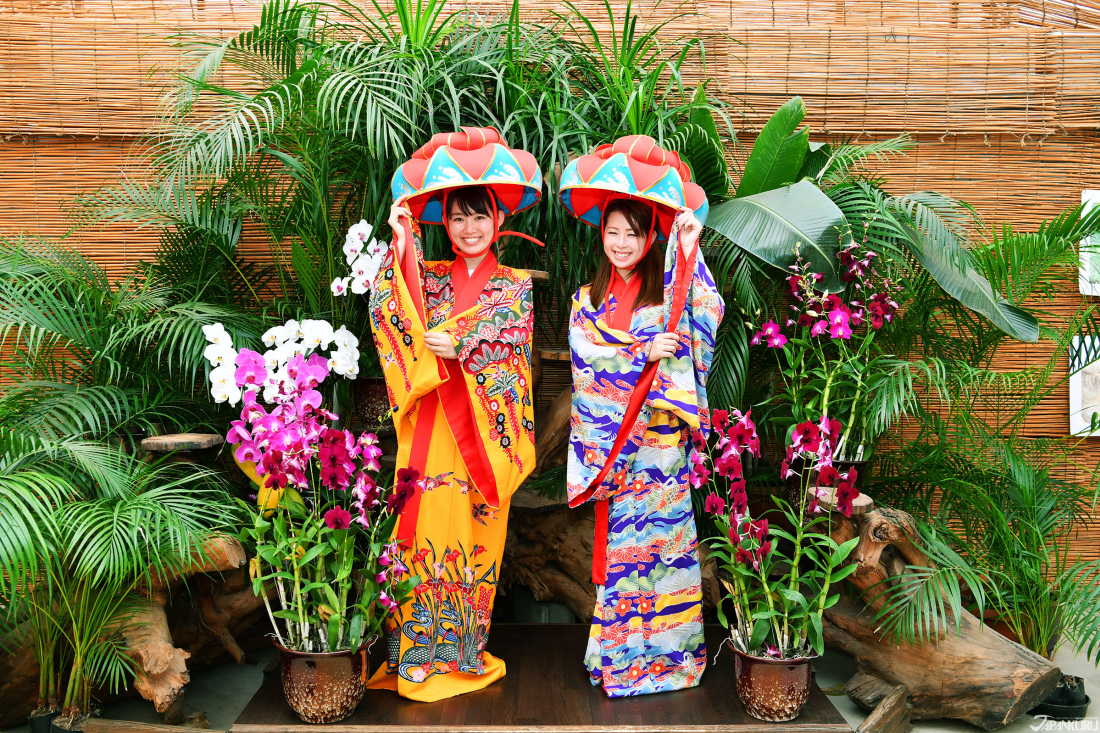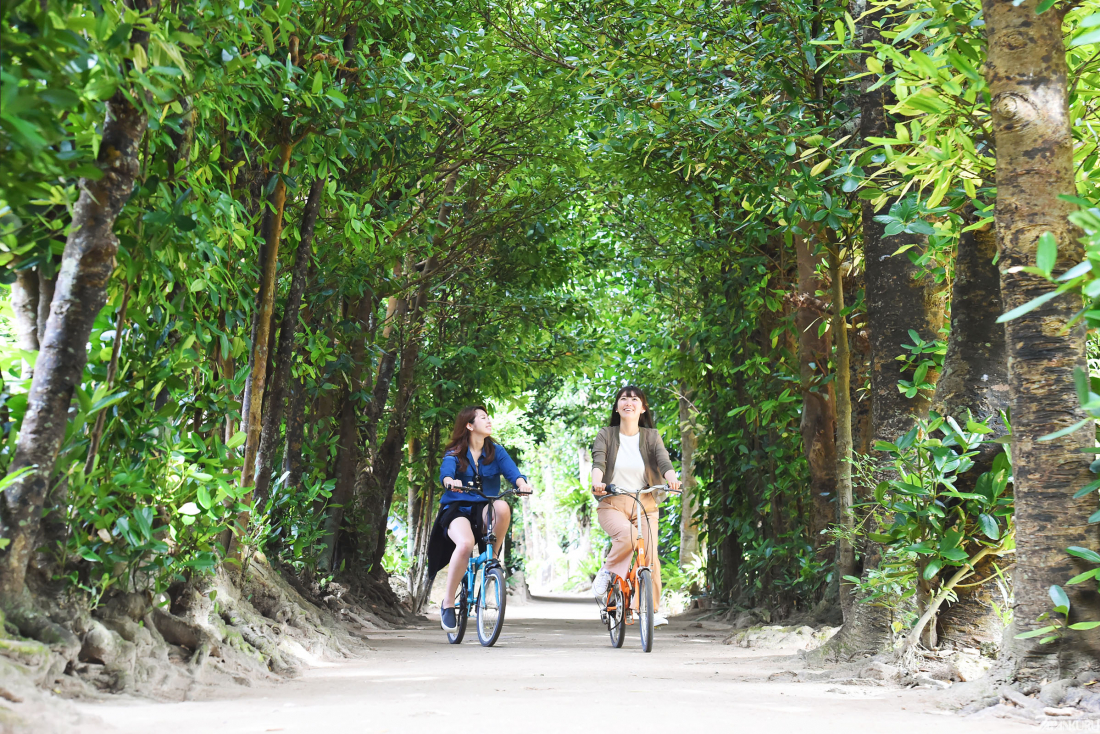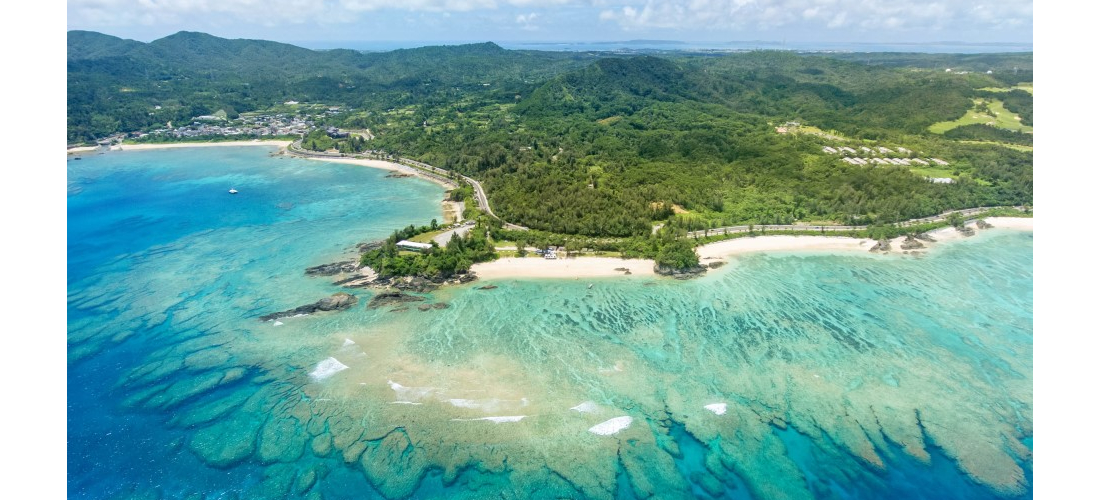
CONTENTS
Feeling tired, cold, and in real need of a beach vacation? Well, it turns out Japan is just the place – you only need to head to the country’s southern reaches, and take a trip to Okinawa! It’s the place to be for families with little kids who want to play in the sand, couples looking for a romantic getaway, and travelers of all kinds who just want to shake the chill from their bones. Need some help planning an Okinawa vacation? Check out some of the best the little chain of islands has to offer!
Okinawa Island

While the Okinawa area is made of quite a few islands, at the center of things is Okinawa Island, the little archipelago’s main island. Bordered by endless pale beaches and surrounded by vast, emerald ocean waters, it’s technically in the subtropics. That means the weather rarely drops below around 15°C (60°F), even in the winter, and the summer heat stays bearable. Thanks to a long history fairly separate from mainland Japan, the native Okinawan Ryukyu culture makes it a totally unique destination!

Okinawa Island stretches long and thin from northeast to southwest, so it’s often broken up into different regions and areas – south, central, and north. For travelers looking to really explore all of Okinawa, you can drive from one end of the island to the other in about three hours. Since the public transportation on the island can be a little iffy, tour buses or rental cars are often the best transportation choices.
If you are thinking about renting a car, you might be relieved to find that Okinawa uses “map codes,” unique numbers assigned to spots all over the world. You don’t have to worry about spelling or pronunciation, just throw the map code number in the Google Maps map code search and you’ll find the directions you’ll need.

For a little extra peace of mind, there’s always Okinawa’s convenient official call center! When you need a little assistance during your travels in Okinawa, talking with a local or planning the rest of your trip, call up the Be.Okinawa Multilingual Contact Center and they’ll help you for free. Pretty handy!
Be.Okinawa Multilingual Contact Center
+81 98-851-7286
(Available in English, Chinese, Korean, & Thai!)
Official Website (en)
Southern Okinawa
Naha’s International Street (Kokusai Dori, 国際通り)

Most travelers visiting Okinawa arrive through Naha International Airport, which makes the southern part of the island a good place to start the trip! And for many, the most obvious destination is Naha’s International Street, a bustling road lined with restaurants offering local delicacies, shops selling Okinawa souvenirs, and plenty of other, well, international travelers. Arriving at the popular destination, it’s hard to believe that it was just a swampy trail before it was transformed during the U.S. occupation of Okinawa.

Not sure what to bring home for souvenirs? Here at Japankuru we always love anything to do with shisa (or shiisaa), Okinawa’s version of the Chinese guardian lion. These little deities are said to protect you from evil spirits!
Shuri Castle (首里城)

A uniquely Okinawan landmark and a UNESCO World Heritage site, Shuri Castle is a destination closely tied with Okinawan history. When a large part of the castle was burned and severely damaged by a fire in 2019, locals stood by with tears in their eyes as firefighters rushed to save as much of the castle complex as possible. But in Japan, buildings are often made of materials meant to be regularly replaced anyway (thatch roofs don’t last forever)! While the castle’s destruction was a tragedy, the building’s caretakers are moving forward, and thinking positive – efforts are already being made to reconstruct the castle buildings. For now, visitors can still access parts of the surrounding castle area, and start making plans to return again when Shuri Castle is restored to its former glory!
Want to help rebuild the castle? Donate to the Shuri Castle Fire Damage Reparation Project here!
Okinawa Soba & Drinks on the Water

Okinawa soba is nothing like the buckwheat soba noodles made on mainland Japan – they’re a unique local specialty, and they taste a little more like udon! The chewy noodles and warm, savory broth make for a satisfying meal, without weighing you down in the warm weather.
Okinawa Soba at Makabechina (茶処 真壁ちなー)
223 Makabe, Itoman, Okinawa
Hours: 11:00 – 15:00 (Closed Wednesdays)
Phone: 098-997-3207
Official Website (jp)

For a cafe that’s both very Okinawa (look at that ocean view), and simultaneously a little international (the menu includes items from across Asia, like the steamed pumpkin filled with coconut milk pudding above), head to Cafe Curcuma for drinks and sweets.
Cafe Curcuma (カフェくるくま)
Chinen-1190 Chinen, Nanjo, Okinawa
Hours: 10:00 – 21:00
Phone: 098-949-1189
Official Website (jp)
Central Okinawa
Cape Zanpa (残波岬) & Cape Manzamo (万座毛)

While there are plenty of things to try and activities to be found in Okinawa, when you’re visiting a place with such beautiful scenery, sometimes you want to just sit back, relax, and enjoy the view! The capes of central Okinawa, where the land juts out into the deep blue waters and make for panoramic beachy views, are popular destinations for a reason. Cape Zanpa’s lighthouse is especially picturesque!

Go a little way along the coast and you’ll find Cape Manzamo. Can you see why lots of travelers are charmed by the shape of the cliff face? It really does look a little like an elephant’s trunk, as it charges into the waves! The name Manzamo, on the other hand, means “a field for 10,000 people to sit,” presumably because of the large grassy space high above the water.
Blue Cave Diving

For travelers who’d like to really dive into the Okinawa experience, try diving in Blue Cave! The open waters all around the island provide some beautiful underwater views, but diving in the dimly lit Blue Cave is a unique experience, and the glow of the water almost seems a little magical.
Blue Cave Diving at Marine Support TIDE ZANPA
950 Senaha, Yomitan, Nakagami District, Okinawa
Fee: 12,000 yen in advance | 13,000 yen day-of
Reservations: Advance reservations can be made up until 3 days ahead of time at contact@bluecavemarintour.com or +81-80-2730-7076.
Official Website (jp)
Colorful Island-Style Drinks

For a sip of something fruity and delicious, and at the same time supremely instagrammable, we recommend the Hawaiian-style smoothies and juices of MAGENTA n blue. You can plop down in their comfortable seating area, or bring some drinks right over to the beach!
MAGENTA n blue
1780 Serakaki, Onna, Kunigami District, Okinawa
Hours: 10:00 – 18:00
Official Instagram
Murasaki Mura Ryukyu Kingdom Theme Park (体験王国むら咲むら)

This complex, surrounded by green fields and turquoise waters, was originally built by NHK studios as the set of a drama they were filming, set in Okinawa. Nowadays, it’s a unique place to immerse yourself in Okinawan traditions and try out some interesting workshops.

Learn about local culture, practice some traditional dances, and try your hand at glassblowing! Ryukyu glass is a traditional local art, and the workshops give you a chance to experiment with it and bring home some very cool tableware!
*workshop fee 2,400 yen

You can also customize your own wearable mementos at Murasaki Mura. Try their screen printing workshop to design your own shirts or tote bags, complete with shisa and other Okinawa-themed designs.
*workshop fee 1,458 yen
Murasaki Mura Ryukyu Kingdom Theme Park (むら咲むら)
1020-1 Takashiho, Yomitan, Nakagami District, Okinawa
Hours: 9:00 – 18:00
Admission Fee: Adults 600 yen | High School/Middle School Students 500 yen | Children 400 yen
Official Website (jp)
Bios Hill (ビオスの丘) Subtropical Forest Theme Park

For a different kind of experiential theme park, stop into Bios Hill for a taste of Okinawa’s subtropical forests. Make your way through the tree-lined streams on canoes, hike through nature, and take in the views of Okinawan flora and fauna.

Since Okinawa was an independent country until 1879, then called the Ryukyu Kingdom, they have their own traditional clothing as well. While these outfits may somewhat resemble Japanese kimono, the shape, materials, and designs make them beautifully unique. Try on an outfit and take some commemorative photos while you’re there – they even have options for babies!
Bios Hill (ビオスの丘)
961-30 Ishikawa Kadekaru, Uruma, Okinawa
Hours: 9:00 – 18:00
Phone: 098-965-3400
Admission Fee: Adults 900 yen | Children ~15 y.o. 500 yen
Official Website (en)
Orion Happy Park – Orion Beer Brewery

Love a good brew? Well, Okinawa has its own major beer brewery, and Orion Beer has earned itself a loyal fanbase. It’s no surprise that they open their brewery for tours, allowing Orion-lovers to learn about the brewing process from knowledgeable tour guides, and see it all in action!

Not only is admission to the Happy Park/factory tour free, but you can finish off the experience with a free tasting as well. Sip on two free draft beers to sample the Okinawa flavors, or go the non-alcohol route and try some of Orion’s soft drinks instead.
Orion Happy Park
2-2-1 Agarie, Nago, Okinawa
Admission: Free!
Hours: 9:20 – 18:40
Official Website (en)
Northern Okinawa
The Bise Fukugi Tree-Lined Road (福木並木)

You’ve probably realized by now that the sand and the sea isn’t the only draw for nature-lovers visiting Okinawa! In the village of Bise, travelers beeline for the “Fukugi Namiki” (福木並木), a road lined with fukugi trees, also known as happiness trees. The trees are maintained to protect local traditional Okinawan-style houses from strong sea breezes, but they create their own jungle-like atmosphere under the leafy canopies.

You can certainly stroll along the road on foot to take in the gentle breeze and dappled sunlight, but we recommend renting bikes and gliding down the paths and around the village. It makes it feel like you should be starring in your own Japanese drama!

Or for a really unique experience, you can also take a little trip in a cart… drawn by water buffalo!
Churaumi Aquarium (美ら海水族館)

A beloved staple of Okinawa sightseeing, plenty of travelers go out of their way and make special trips to northern Okinawa just to visit the fabulous Churaumi Aquarium. Of particular note is the huge central tank, which gives visitors a view deep into a recreation of the ocean right outside the facility. It houses multiple enormous whale sharks, native to the Okinawan seas, which drift gracefully through the eddies, and then feed standing vertically in the water!
Churaumi Aquarium (美ら海水族館)
424 Ishikawa, Motobu, Kunigami District, Okinawa
Hours: Oct. to Feb. 8:30 – 18:30 | Mar. to Sep. 8:30 – 20:00
Admission Fee: Adults 1,850 yen | High School Students 1,230 yen | Elementary/Middle School Students 610 yen | Children under 6 are free!
Official Website
Yachimun Cafe’s Shisa Garden (やちむん喫茶シーサー園)

Rain or shine, a seat on the porch of Yachimun Cafe, looking out on the brilliant green of the garden with a roof over your head, is the perfect break from a busy sightseeing schedule. Instead of a beach view, this cafe has a “shisa garden,” and the little guardians gaze back at you as you sip a refreshing glass of tea or fruit juice.
Yachimun Cafe Shisa Garden (やちむん喫茶シーサー園)
1439 Izumi, Motobu, Kunigami District, Okinawa
Hours: 11:00 – 19:00 (Closed Mondays & Tuesdays)
Phone: 0980-47-2160
Okinawa: Japan’s Year-Round Summer Island Destination

Even in Japan, an island country, surrounded on all sides by beaches and ocean water, Okinawa is the clear island getaway destination. Warm and sunny year-round, it’s the perfect place for travelers looking for a healthy tan, a little bit of ocean adventure, and some fascinatingly unique (Ryukyu!) culture.

And if you’ve still got questions about traveling in Okinawa, there’s always the official contact center. Ring them up for answers to all your queries, help with Japanese, and plenty of other recommendations for destinations all over the Okinawa islands. They’re there to help, and they know a lot about the area, we promise!
Be.Okinawa Multilingual Contact Center
+81 98-851-7286
(Available in English, Chinese, Korean, & Thai!)
Official Website (en)
Details
NAME:Be.Okinawa Multilingual Contact Center
MAP
https://www.visitokinawa.jp/for-visitors/multilingual-contact-center
COMMENT
FEATURED MEDIA
VIEW MORE 
A New Tokyo Animal Destination: Relax & Learn About the World’s Animals in Japan
#pr #japankuru #anitouch #anitouchtokyodome #capybara #capybaracafe #animalcafe #tokyotrip #japantrip #카피바라 #애니터치 #아이와가볼만한곳 #도쿄여행 #가족여행 #東京旅遊 #東京親子景點 #日本動物互動體驗 #水豚泡澡 #東京巨蛋城 #เที่ยวญี่ปุ่น2025 #ที่เที่ยวครอบครัว #สวนสัตว์ในร่ม #TokyoDomeCity #anitouchtokyodome

Shohei Ohtani Collab Developed Products & Other Japanese Drugstore Recommendations From Kowa
#pr #japankuru
#kowa #syncronkowa #japanshopping #preworkout #postworkout #tokyoshopping #japantrip #일본쇼핑 #일본이온음료 #오타니 #오타니쇼헤이 #코와 #興和 #日本必買 #日本旅遊 #運動補充能量 #運動飲品 #ช้อปปิ้งญี่ปุ่น #เครื่องดื่มออกกำลังกาย #นักกีฬา #ผลิตภัณฑ์ญี่ปุ่น #อาหารเสริมญี่ปุ่น

도쿄 근교 당일치기 여행 추천! 작은 에도라 불리는 ‘가와고에’
세이부 ‘가와고에 패스(디지털)’ 하나면 편리하게 이동 + 가성비까지 완벽하게! 필름카메라 감성 가득한 레트로 거리 길거리 먹방부터 귀여움 끝판왕 핫플&포토 스폿까지 총집합!
Looking for day trips from Tokyo? Try Kawagoe, AKA Little Edo!
Use the SEIBU KAWAGOE PASS (Digital) for easy, affordable transportation!
Check out the historic streets of Kawagoe for some great street food and plenty of picturesque retro photo ops.
#pr #japankuru #도쿄근교여행 #가와고에 #가와고에패스 #세이부패스 #기모노체험 #가와고에여행 #도쿄여행코스 #도쿄근교당일치기 #세이부가와고에패스
#tokyotrip #kawagoe #tokyodaytrip #seibukawagoepass #kimono #japantrip

Hirakata Park, Osaka: Enjoy the Classic Japanese Theme Park Experience!
#pr #japankuru #hirakatapark #amusementpark #japantrip #osakatrip #familytrip #rollercoaster #retrôvibes #枚方公園 #大阪旅遊 #關西私房景點 #日本親子旅行 #日本遊樂園 #木造雲霄飛車 #히라카타파크 #สวนสนุกฮิราคาตะพาร์ค

🍵Love Matcha? Upgrade Your Matcha Experience With Tsujiri!
・160년 전통 일본 말차 브랜드 츠지리에서 말차 덕후들이 픽한 인기템만 골라봤어요
・抹茶控的天堂!甜點、餅乾、飲品一次滿足,連伴手禮都幫你列好清單了
・ส่องมัทฉะสุดฮิต พร้อมพาเที่ยวร้านดังในอุจิ เกียวโต
#pr #japankuru #matcha #matchalover #uji #kyoto #japantrip #ujimatcha #matchalatte #matchasweets #tsujiri #말차 #말차덕후 #츠지리 #교토여행 #말차라떼 #辻利抹茶 #抹茶控 #日本抹茶 #宇治 #宇治抹茶 #日本伴手禮 #抹茶拿鐵 #抹茶甜點 #มัทฉะ #ของฝากญี่ปุ่น #ชาเขียวญี่ปุ่น #ซึจิริ #เกียวโต

・What Is Nenaito? And How Does This Sleep Care Supplement Work?
・你的睡眠保健品——認識「睡眠茶氨酸錠」
・수면 케어 서플리먼트 ‘네나이토’란?
・ผลิตภัณฑ์เสริมอาหารดูแลการนอน “Nenaito(ネナイト)” คืออะไร?
#pr #japankuru #sleepcare #japanshopping #nenaito #sleepsupplement #asahi #睡眠茶氨酸錠 #睡眠保健 #朝日 #l茶胺酸 #日本藥妝 #日本必買 #일본쇼핑 #수면 #건강하자 #네나이토 #일본영양제 #อาหารเสริมญี่ปุ่น #ช้อปปิ้งญี่ปุ่น #ร้านขายยาญี่ปุ่น #ดูแลตัวเองก่อนนอน #อาซาฮิ

Japanese Drugstore Must-Buys! Essential Items from Hisamitsu® Pharmaceutical
#PR #japankuru #hisamitsu #salonpas #feitas #hisamitsupharmaceutical #japanshopping #tokyoshopping #traveltips #japanhaul #japantrip #japantravel

Whether you grew up with Dragon Ball or you just fell in love with Dragon Ball DAIMA, you'll like the newest JINS collab. Shop this limited-edition Dragon Ball accessory collection to find some of the best Dragon Ball merchandise in Japan!
>> Find out more at Japankuru.com! (link in bio)
#japankuru #dragonball #dragonballdaima #animecollab #japanshopping #jins #japaneseglasses #japantravel #animemerch #pr

This month, Japankuru teamed up with @official_korekoko to invite three influencers (originally from Thailand, China, and Taiwan) on a trip to Yokohama. Check out the article (in Chinese) on Japankuru.com for all of their travel tips and photography hints - and look forward to more cool collaborations coming soon!
【橫濱夜散策 x 教你怎麼拍出網美照 📸✨】
每次來日本玩,是不是都會先找旅日網紅的推薦清單?
這次,我們邀請擁有日本豐富旅遊經驗的🇹🇭泰國、🇨🇳中國、🇹🇼台灣網紅,帶你走進夜晚的橫濱!從玩樂路線到拍照技巧,教你怎麼拍出最美的夜景照。那些熟悉的景點,換個視角說不定會有新發現~快跟他們一起出發吧!
#japankuru #橫濱紅磚倉庫 #汽車道 #中華街 #yokohama #japankuru #橫濱紅磚倉庫 #汽車道 #中華街 #yokohama #yokohamaredbrickwarehouse #yokohamachinatown

If you’re a fan of Vivienne Westwood's Japanese designs, and you’re looking forward to shopping in Harajuku this summer, we’ve got important news for you. Vivienne Westwood RED LABEL Laforet Harajuku is now closed for renovations - but the grand reopening is scheduled for July!
>> Find out more at Japankuru.com! (link in bio)
#japankuru #viviennewestwood #harajuku #omotesando #viviennewestwoodredlabel #viviennewestwoodjapan #비비안웨스트우드 #오모테산도 #하라주쿠 #日本購物 #薇薇安魏斯伍德 #日本時尚 #原宿 #表參道 #japantrip #japanshopping #pr

Ready to see TeamLab in Kyoto!? At TeamLab Biovortex Kyoto, the collective is taking their acclaimed immersive art and bringing it to Japan's ancient capital. We can't wait to see it for ourselves this autumn!
>> Find out more at Japankuru.com! (link in bio)
#japankuru #teamlab #teamlabbiovortex #kyoto #kyototrip #japantravel #artnews
Photos courtesy of teamLab, Exhibition view of teamLab Biovortex Kyoto, 2025, Kyoto ® teamLab, courtesy Pace Gallery

Japanese Makeup Shopping • A Trip to Kamakura & Enoshima With Canmake’s Cool-Toned Summer Makeup
#pr #canmake #enoshima #enoden #에노시마 #캔메이크 #japanesemakeup #japanesecosmetics

⚔️The Robot Restaurant is gone, but the Samurai Restaurant is here to take its place. Check it out, and don't forget your coupon!
🍣신주쿠의 명소 로봇 레스토랑이 사무라이 레스토랑으로 부활! 절찬 쿠폰 발급중
💃18歲以上才能入場的歌舞秀,和你想的不一樣!拿好優惠券去看看~
#tokyo #shinjuku #samurairestaurant #robotrestaurant #tokyotrip #도쿄여행 #신주쿠 #사무라이레스토랑 #이색체험 #할인이벤트 #歌舞伎町 #東京景點 #武士餐廳 #日本表演 #日本文化體驗 #japankuru #japantrip #japantravel #japanlovers #japan_of_insta

Japanese appliance & electronics shopping with our KOJIMA x BicCamera coupon!
用JAPANKURU的KOJIMA x BicCamera優惠券買這些正好❤️
코지마 x 빅 카메라 쿠폰으로 일본 가전 제품 쇼핑하기
#pr #japankuru #japanshopping #kojima #biccamera #japaneseskincare #yaman #dji #osmopocket3 #skincaredevice #日本購物 #美容儀 #相機 #雅萌 #日本家電 #일본여행 #면세 #여행꿀팁 #일본쇼핑리스트 #쿠폰 #일본쇼핑 #일본브랜드 #할인 #코지마 #빅카메라 #japankurucoupon
















































